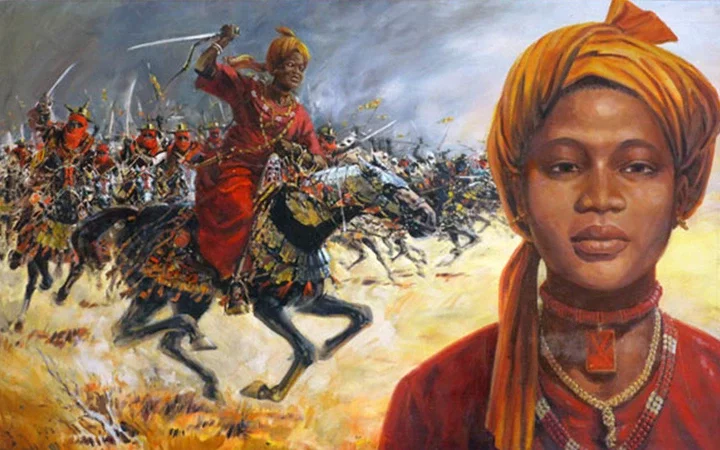You've probably never heard of the story of Queen Amina before, but she was one seriously impressive lady. Back in the 1500s in what is now Nigeria, she managed to rule and expand her kingdom while also being a total warrior. Can you imagine a queen leading armies into battle herself? Amina did. She was smart, brave, and powerful at a time when most women had little say in politics or war. But Amina commanded armies of 20,000 soldiers and led them on conquests expanding her kingdom. She even designed a new city as her capital with huge walls for protection.
Though she lived centuries ago, Amina achieved things most women wouldn't dare try even today. Intrigued yet? Read on to uncover the remarkable story of the warrior queen Amina of Zaria.
The Story of Amina of Zaria

Amina was born around 1533 to Queen Bakwa Turunku and King Nikatau of Zazzau. Amina was the eldest of three children. She had a brother named Karama and a sister named Zaria. At 16, Amina took over as queen after her mother's death. She was a skilled military leader and greatly expanded the Zazzau kingdom through her military conquests.
Under Amina's 34-year reign, Zazzau tripled in size. She built many of the walled fortifications that protected cities within the kingdom. Amina commanded an all-female cavalry and led military campaigns herself. She never lost a battle, earning her the name "Amina, Queen of Queens".
Amina promoted free trade and made Zazzau very prosperous. She built many roads to connect parts of the kingdom. She encouraged farmers and traders from around the region to settle in Zazzau. The kingdom became a major center of trade and knowledge during her reign.
Amina remains a legend in Nigeria today. Her rule represents an era when women had significant leadership roles in government and the military. She serves as an example of a visionary and strategically-minded leader. Amina, the warrior queen, led Zazzau to become the most powerful kingdom in Northern Nigeria during the 16th century.
Early Life of Amina of Zaria
Amina was born in the mid-16th century CE to King Nikatau, the 22nd king of Zazzau, and Queen Bakwa Turunku (r. 1536-c. 1566). She had a younger sister named Zaria, after whom the British dubbed modern-day Zaria (Kaduna State) in the early twentieth century. According to oral stories gathered by anthropologist David E. Jones, Amina was raised in her grandfather's palace and favored by him. He took her to court and painstakingly taught her on political and military issues.
Amina was named Magajiya (heir apparent) at the age of sixteen and assigned forty female slaves (kuyanga). Amina was courted by several suitors from a young age. "A daily offer of ten slaves" from Makama and "fifty male slaves and fifty female slaves as well as fifty bags of white and blue cloth" from the Sarkin Kano were among the attempts to gain her hand. Amina's brother became king of Zazzau after her parents died, which occurred in or around 1566. Amina had already established herself as a "leading warrior in her brother's cavalry" and had achieved recognition for her military prowess. She is still praised in traditional Hausa praise songs as "Amina daughter of Nikatau, a woman as capable as a man that was able to lead men to war."
Queenship and Expansion of Zazzau
Following the death of her brother Karami in 1576, Amina became queen. Zazzau was one of the original seven Hausa States (Hausa Bakwai), with Daura, Kano, Gobir, Katsina, Rano, and Garun Gabas. Before Amina took the throne, Zazzau was one of the largest of these states. It was also the principal source of slaves for Arab traders to sell at the Kano and Katsina slave markets. Only three months after being crowned queen, Amina launched a 34-year struggle against her neighbors to extend Zazzau territory. Her army, made up of 20,000 foot men and 1,000 cavalry troops, was well-trained and formidable.
Amina took advantage of the region's political instability. She captured the Nupe town of Kwara, gaining control of trade routes. Her military prowess earned her the moniker 'Amina, daughter of Nikatau, a woman as capable as a man.'
Amina established Zazzau as a center of trade and diplomacy. Her reign brought increased prosperity and security to the kingdom. Amina built earthen walls around her cities to distinguish and safeguard her new territories. These fortifications grew ubiquitous throughout the country until the British conquered Zazzau in 1904, and many of them are still standing today, known as ganuwar Amina (Amina's walls).
Amina remains a revered figure in Hausa history. Her military and leadership skills were unmatched, securing her place as a legendary queen who expanded and strengthened Zazzau. She serves as an enduring symbol of courage, vision, and strength.
The Prosperity of Zaria Under Queen Amina's Rule
Under Queen Amina's rule, the kingdom of Zaria prospered and expanded. As a skilled military leader, Queen Amina led many successful campaigns against neighboring kingdoms, expanding Zaria's territory. The increased size of Zaria meant greater access to resources and trade routes.
Queen Amina also invested in infrastructure within Zaria, building roads to connect parts of the kingdom and facilitate trade. She encouraged agriculture by providing farmers with seeds and tools. Queen Amina promoted trade by reducing tariffs, making it easier for merchants to do business in Zaria.
Death of Amina of Zaria
Amina died in 1610. According to historians, she died at the age of 77. The exact cause of her death remains unknown. However, it is believed that old age and battle wounds contributed to her death.
Over the course of her 34-year reign, Amina had led her troops in many battles and sustained injuries. The frequent horse riding and combat also took a toll on her health over time. By the time she reached her 60s, the ailments and untreated wounds likely weakened her body. Her age and weakening health made her vulnerable to diseases and infections.
Some accounts say Amina died in her sleep peacefully at her palace in Zaria. Others claim she died on her way to raid a neighboring kingdom.
According to 19th-century Muslim historian Dan Tafa, "She died in a place called Attaagar." Sidney John Hogben, citing Tafa's story, writes that "Amina died in Atagara, near present-day Idah, for at that time Amina had pushed the limits of Zazzau south of the Niger-Benue confluence. However, there are many disputes surrounding her death; several authors in their publications state that she died in Vom Jos, whilst other historians claim she died in Atagara, which is now Idah.
Regardless of the exact circumstances, Amina's death marked the end of a memorable and influential reign. She was buried in Zaria, and her tomb remains an important historical site today.
Amina's death was deeply mourned in her kingdom. Under her leadership, Zaria had grown prosperous and secure. She was admired by her subjects for her military prowess, leadership, and justice. Amina's reign as queen and commander-in-chief spanned more than three decades, cementing her status as a legend in Zaria and inspiring generations to come.
The Legacy and Significance of Queen Amina of Zaria
Amina was a warrior queen who ruled Zazzau, a province of Hausa city-states in what is now northern Nigeria, from 1576 to 1610. She was the daughter of Bakwa Turunku, who founded the Zazzau kingdom in the early 16th century. After Bakwa's death, Amina ruled as queen over Zazzau and expanded its borders through military conquest.
Queen Amina of Zaria was known as a brilliant military strategist, Amina led her army on daring military exploits, expanding her kingdom through cunning military conquests. She built up a large empire that stretched over a wide area.
Amina's legacy lives on today. She is revered as a symbol of courage, power and leadership in Nigeria. Her rule brought political and economic stability to the region. Trade and commerce grew, and Zaria became a center of trade and culture. She continues to inspire women in positions of leadership and power. Amina demonstrated that women are capable of ruling successfully in a male-dominated society. Her story is a beacon of hope that perseverance and determination can overcome obstacles like gender.
Though Amina's kingdom fell after her death, her legend and legacy endure. She is remembered as a pioneer who expanded and strengthened one of the most powerful empires in West Africa during her time. Amina remains an important figure in Nigerian history and culture. Her story deserves to be told.
Modern Cultural Depictions
Queen Amina's exploits have inspired many modern cultural depictions. She has been featured in popular media like books, movies, video games, and music. Some notable examples:
The movie "Queen Amina" (1977) helped bring her story to the mainstream. It chronicled her military campaigns and rise to power in the Zazzau kingdom.
Amina is referenced in several Afrobeat songs as a symbol of strength, courage and African pride. Artists like Femi Kuti, Seun Kuti, and Brymo have mentioned her in their lyrics.
The Queen Amina Statue at the National Arts Theatre in Lagos State recognizes her.
Amina is the protagonist of J.S. Emuakpor's historical fantasy novel Queen of Zazzau (2018), which is based on her life from 1557 CE.
According to Roye Okupe's coloring book, Amina inspired the character Malika in his graphic novel Malika: Warrior Queen (2017).
In Education, the fifth episode of Steve McQueen's Small Axe films, 12-year-old Kingsley Smith joyously recounts Amina's narrative to his family after learning to read.
In the video game Age of Empires III: Definitive Edition, Queen Amina is the leader of the Hausa civilization.
Amina's legacy as a formidable female warrior-queen has made her an icon for feminism and gender equality. She continues to inspire women today to break barriers in leadership roles that have traditionally been held by men.
Though many centuries have passed, Queen Amina remains a pivotal figure in Nigerian history and culture. Her story of overcoming immense challenges to become one of the most powerful rulers of her time continues to captivate people all over the world.
Frequently Asked Questions
Have questions about the famous Queen Amina of Zaria? Here are some common ones:
How did Amina become queen?
Amina was born in 1533 to Queen Bakwa of Zazzau and became the heir apparent, after the death of her brother Karami. She ruled as queen from 1576 to 1610, succeeding her mother.
Did Amina have any children?
No, Amina never married and had no children. She devoted her life to expanding the Zazzau Kingdom.
What was Amina known for?
Amina was a renowned military leader and expanded the Zazzau Kingdom through military conquests. She led her first military campaign at age 16 and continued fighting until her death at age 77.
How did Amina die?
The exact cause of Amina's death is unknown. According to legend, she died during a military campaign in 1610 at the age of 77. She was buried in her capital city of Zaria, where her tomb remains a popular tourist site today.
Why was Amina important?
Amina was an iconic figure who defied gender stereotypes in a male-dominated society. Her military and leadership achievements demonstrate that women can be powerful rulers and expand empires, not just men. She serves as an enduring inspiration and role model for women in Nigeria and beyond.
How did Amina expand her kingdom?
Through military conquests, Amina led her army to conquer neighboring territories and incorporate them into Zazzau. Her military prowess allowed Zazzau to become a dominant force in the region.
What happened to Amina?
The details of Amina's later life and death are unclear. Some accounts say she died during a military campaign at an old age. She had no known heirs, but Zazzau continued to thrive for 200 years after her reign. Amina's accomplishments cemented her status as a legend.
Who was Queen Amina's father?
Amina's father was King Nikatau of Zazzau.
Who was Amina's mother?
Her mother was Queen Bakwa Turunku.
What was Queen Amina of Zaria known for?
Amina was best known as a fierce warrior queen who expanded the Zazzau kingdom through military conquests. She never lost a battle during her 34-year reign.
Conclusion
That's the story of Amina of Zaria, a true warrior queen. From leading military campaigns to building protective walls, she showed incredible strength, courage, and leadership. Though her reign was centuries ago, Queen Amina remains an enduring symbol of power for women across Africa and around the world. So next time you hear someone say a woman can't be a great leader, tell them about Amina! She more than earned her nickname "Amina the Great." And her legacy lives on as an inspiration. Who knows, maybe someday the story of your own brave accomplishments will inspire future generations too.

















Comments